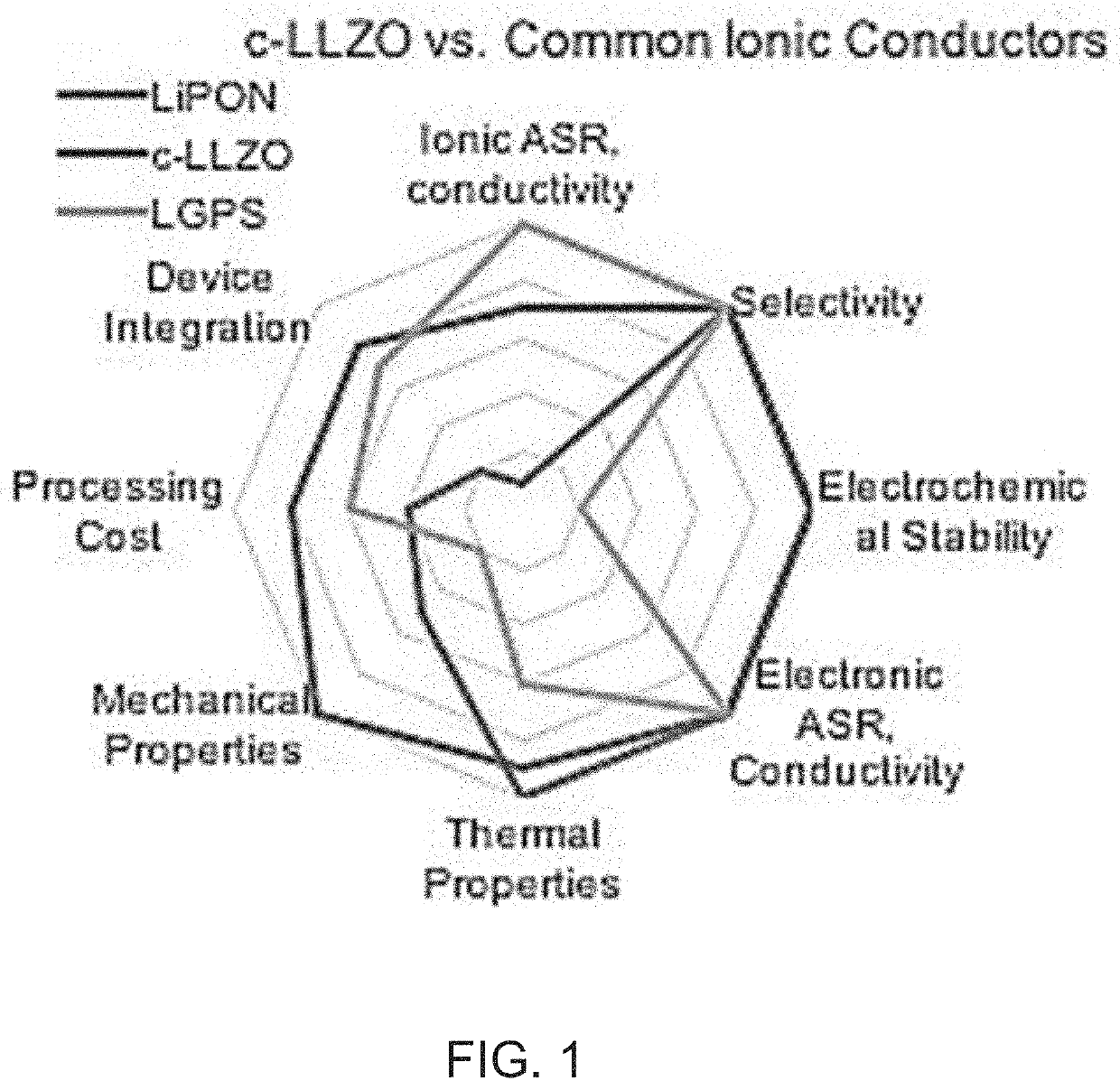Microscopically ordered solid electrolyte architecture manufacturing methods and processes thereof for use in solid-state and hybrid lithium ion batteries
a solid electrolyte architecture and microscopy-ordered technology, which is applied in the manufacture of final products, cell components, electrochemical generators, etc., can solve the problems of short circuit over the life of batteries, limited energy density of current lib cathodes, and loss of capacity
- Summary
- Abstract
- Description
- Claims
- Application Information
AI Technical Summary
Benefits of technology
Problems solved by technology
Method used
Image
Examples
example 1
[0132]In one embodiment of the present invention, the microscopically ordered solid electrolyte architecture is comprised of c-LLZO that is formed by freeze tape casting and subsequently sintering a slurry comprising water, c-LLZO nanoparticles of particle size 400 nm, and several additives as described below.
[0133]First, a mixture of 35 g LLZO, 2.3% Li2CO3 sintering additive by weight, 43.5% water by weight, 0.7% Evonik SURFYNOL® CT-324 dispersant by weight, and 50% ZrO2 / Y2O3 milling media by volume was ball milled in a 250 mL jar for 16 hours.
[0134]Next, 4% acrylic co-polymer emulsion binder by weight was added to the mixture and the mixture was subsequently ball milled for 4 hours.
[0135]Next, a 1.25% by weight xanthan gum solution in water was prepared and added to the mixture 32.6% by weight. 0.4% Evonik SURFYNOL® DF-37 defoamer by weight was added and the mixture was mixed using an impeller, then on a ball mill with the milling media removed.
[0136]Next, the mixture was de-aired...
example 2
[0139]In one embodiment of the present invention, the microscopically ordered solid electrolyte architecture was comprised of c-LLZO that was formed by freeze tape casting and subsequently sintering a slurry consisting of water, c-LLZO nanoparticles of particle size 400 nm, and several additives as described below.
[0140]First, a mixture of 35 g LLZO, 2.3% Li2CO3 sintering additive by weight, 43.5% water by weight, 0.7% Dow ECOSURF™ EH-9 dispersant by weight, and 50% ZrO2 / Y2O3 milling media by volume was ball milled in a 250 mL jar for 16 hours.
[0141]Next, 4% Dow RHOPLEX™ HA-12 acrylic co-polymer emulsion binder by weight was added to the mixture and the mixture was subsequently ball milled for 4 hours.
[0142]Next, a 1.25 weight % xanthan gum solution in water was prepared and added to the mixture 32.6% by weight. 0.4% SURFYNOL® DF-37 defoamer by weight was added and the mixture was mixed using and impeller, then a ball mill with the milling media removed.
[0143]Next, the mixture was d...
example 3
[0146]In one embodiment of the present invention, the microscopically ordered solid electrolyte architecture was comprised of c-LLZO that was formed by tape casting and subsequently sintering a slurry consisting of water, c-LLZO nanoparticles of particle size 400 nm, and several additives as described below.
[0147]First, a mixture of 10.19 g LLZO, 5.4% Li2CO3 sintering additive by weight, 3.41% benzyl butyl phthalate plasticizer, 24.14% ethanol, 23.57% acetone are ball milled for 16 hours at 114 rpm using 96 g of ZrO2 / Y2O3 milling media. Then 3.41% by weight polyvinyl butyral (Butvar B-98) binder was added to the slurry and ball milled for an additional 4 hours.
[0148]Next, the slurry was tape cast to produce a dense green ceramic tape. In this process, the mixture was poured into a hopper above a silicone-coated boPET carrier film. Then, the slurry was drawn through a doctor blade at a set gap height of 0.05 mm at 1 m / min onto the carrier film which was moved across a flat casting su...
PUM
| Property | Measurement | Unit |
|---|---|---|
| pore size | aaaaa | aaaaa |
| thickness | aaaaa | aaaaa |
| thickness | aaaaa | aaaaa |
Abstract
Description
Claims
Application Information
 Login to View More
Login to View More - R&D
- Intellectual Property
- Life Sciences
- Materials
- Tech Scout
- Unparalleled Data Quality
- Higher Quality Content
- 60% Fewer Hallucinations
Browse by: Latest US Patents, China's latest patents, Technical Efficacy Thesaurus, Application Domain, Technology Topic, Popular Technical Reports.
© 2025 PatSnap. All rights reserved.Legal|Privacy policy|Modern Slavery Act Transparency Statement|Sitemap|About US| Contact US: help@patsnap.com



